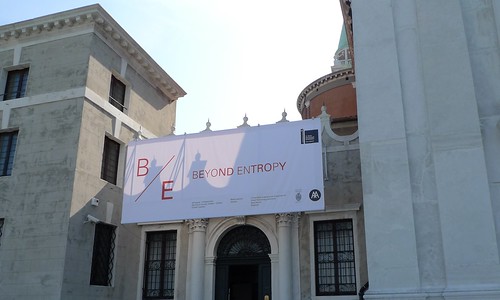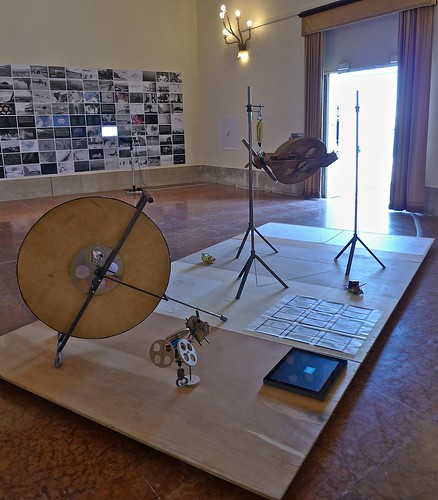As a scientist, I am used to my work being read by my peers, and I’ve made it into the occasional magazine or newspaper article, and even the odd TV and radio slot. But last week I travelled to Venice’s Architecture Biennale for the culmination of the first phase of the Architectural Association’s Beyond Entropy art/science project (which I’ve described before). I took a vaporetto to the island of San Giorgio, and next to one of Venice’s more spectacular Palladian churches, I saw the Beyond Entropy banner hanging over the entrance:
 (I took these pictures, but there are many much more professional ones taken by the AA’s Valerie Bennett.)
(I took these pictures, but there are many much more professional ones taken by the AA’s Valerie Bennett.)
Before arriving, I didn’t know what to expect from the project: small-scale, low-key, amateurish? In this setting, it was clearly big and serious. And inside this lovely building were these, the prototypes for our time machine: 
Last year I traveled to South America to witness the launch of our several-hundred million-Euro Planck satellite, surely a big and serious project. But the sight of my own work — our texts, flywheels and gyroscopes — sitting on a plywood plinth, plausibly described as something at least related to the very different creative process of art, was nearly as disconcerting (despite the lack of highly explosive rocket fuel).
I’ll leave any assessment of the overall quality to others, although it became obvious that these pieces really are prototypes for what could become more finished works, but we have a long way to go. Nonetheless, let me explicitly thank my collaborators, Shin Egashira (whom I will also congratulate on his wedding which gave him an excellent reason to not show up in Venice) and Scrap Marshall, a student at the Architectural Association who joined us toward the end of the project and did an enormous amount of practical and creative work getting our pieces together. From speaking to members of some of the other groups, we were lucky to all be based in London, and to eventually come to see our project in similar ways, albeit from different directions; some of the more widely-dispersed groups had to deal with significantly greater practical problems, and the interpersonal ones those ended up causing.
That first day was dedicated to the AA’s visiting school, and the next day was the centrepiece: a marathon symposium of more than thirty talks, dedicated to the themes of “entropy” and “energy”. Remarkably, none of our projects addressed the ecological, societal and political aspects of these topics, while many of the speakers attacked them directly, from Richard Burdett and Reinier de Graaf’s complementary discussions of the bleak picture for energy and climate if we keep to “business as usual” in our habits of consumption and production, to Italian Green Party politician Grazia Francescato’s hopeful discussion of “Green Jobs and Green Economy”. There were a few talks on science per se, from Angelo Merlina’s brief introduction to the LHC at CERN (of which a third talked about cosmology, and a third was pre-recorded), to one of my favourites, biophysicist Tania Saxl’s description of the amazing mechanism behind the motion of rotating bacterial flagella. There was also an inexplicable prerecorded description of “parallel worlds” in film from de Gruyter and Thys, a performance from the Arazzi Laptop ensemble, and contributions from Serpentine Gallery curator Hans-Ulrik Obrist (which was interesting but mostly about himself) and Charles Jencks. Jencks tackled the overlap between science, art and architecture head-on, each as a different metaphorical system for describing and interacting with the world. This culminates in his Scottish Garden of Cosmic Speculation, a hugely symbolic landscape replete with double helixes and grassy knolls in the form of black hole spacetime diagrams (I admit I’ve also found these supposed metaphors a bit too, well, literal for my taste — with insufficient information to be effective teaching tools, but too didactic to be truly beautiful.) I think the most important thing I learned was that, in their own way, the architects are just as nerdy as us scientists, but just better looking dressed.
Also, there was plenty of fine food and free-flowing sparkling wine (which meant that I probably missed about half of the presentations).
Finally, I would like to thank everyone from the AA who made the project happen (and will continue to do so, if further funding is forthcoming): Artemis Doupa, Sylvie Taher, Esther McLaughlin, Aram Mooradian and most especially the ever-enthusiastic project director, Stefano Rabolli Pansera. Thanks also to the AA visiting students, and all of the other participants, especially Ariel Schlesinger and Wilfredo Prieto for giving me a glimpse of the Architecture Biennale through artists’ eyes.
One response to “B/E at the Biennale”
Beyond Entropy and Ourselves
Last summer, I helped make a (fake) time machine, an exercise in “creative misinterpretation” (in the words of my architect partner, Shin Egashira). This was part of the Beyond Entropy project organized by the Architecture Association ̵…